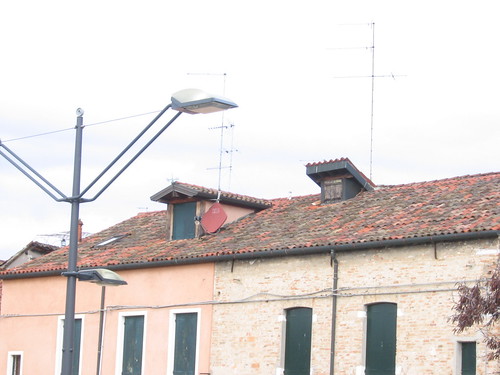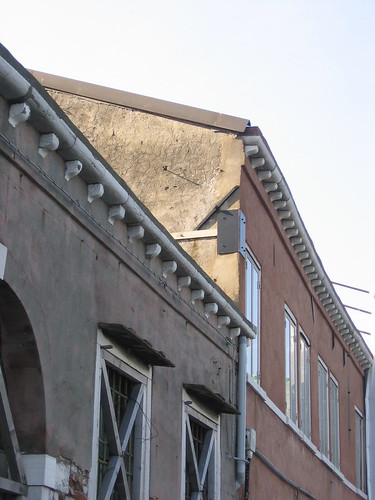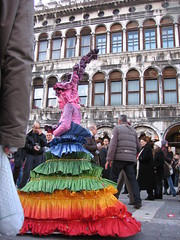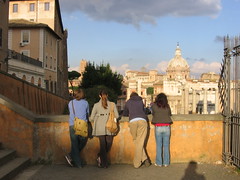
2.21.2008
Dancing Lady in Rome
Labels:
photos
There is this lady who lives in Rome. She can often be found in the streets, near Campo Di Fiori or in Trastevere, dancing to the music of a stereo system she has set up. The music she plays is in stark contrast to her clothing and demeanor, usually American 'top 40' or dance music. She wears the trappings of a homeless woman and is probably in her 70's. Awkwardly, she swings her hands back and forth in a very strange but particular dancing mode. She is very popular, and seems to make a lot of money, based largely on the apparent quaintness of her incongruity. A rather grim looking man usually lurks somewhere in the vacinity, smoking cigarettes. He wears very white sneakers, but is otherwise unremarkable.


2.15.2008
Notes on the Ara Pacis
Labels:
prose _ nonfiction,
sketch
At the Ara Pacis Augustae in Rome the architecture of the museum intersects interestingly with another system, derived from issues of egress and life-safety. Two logics, based on different values, are layered one upon the other. First, the Roman Superintendent of Culture and History, in conjunction with the design team, has set up a framework for the idolization of an artifact, with particular political and philosophical objectives. The Ara Pacis represents the return of Augustus from "pacifying" his enemies, successfully spreading peace, order and infrastructure throughout the empire. The contemporary fetishization of this moment in history comes from a desire to remember Rome's one-time value and, in turn, anticipate the return of this value. The construction of this new museum is a direct act of myth-making. This agenda is clearly mapped out in the ichnography of the building. The fear of fire, or at least the institutionalized residue of a fear of fire, presumably truly felt by someone at some time but we don't know who, introduces a second logic with a second ichnography. This system is laid out over the first system, using the architecture as its starting point. In this interplay between the two logics, two hands are obviously at play with two different agendas.

The Ara Pacis has the potential to be a stimulating, profound experience - a meeting of contemporary individuals with the greatness of the past - an opportunity to contemplate a stimulating, inspiring story of victory over chaos and turbulence by order and peace. If the Ara Pacis is about the victory of the Pax Augustae over the chaos and turbulence of the hordes, the fire extinguishers represent this victory again as the victory of order and safety over danger (likewise with the small army of security guards). The pattern of extinguishers represent a new order, the protection of the museum-goers from another sort of chaos: fire, entropy, the degradation of energy. Unfortunately, this victory is not only over fire, but also the aesthetic experience. In this situation it seems that our fear of disorder (represented by the rather absurd possibility of fire) is so strong that it seriously undermines the aesthetic and, dare I say it, the "poetic" possibilities of the space. Which is, I think, very interesting.

The Ara Pacis has the potential to be a stimulating, profound experience - a meeting of contemporary individuals with the greatness of the past - an opportunity to contemplate a stimulating, inspiring story of victory over chaos and turbulence by order and peace. If the Ara Pacis is about the victory of the Pax Augustae over the chaos and turbulence of the hordes, the fire extinguishers represent this victory again as the victory of order and safety over danger (likewise with the small army of security guards). The pattern of extinguishers represent a new order, the protection of the museum-goers from another sort of chaos: fire, entropy, the degradation of energy. Unfortunately, this victory is not only over fire, but also the aesthetic experience. In this situation it seems that our fear of disorder (represented by the rather absurd possibility of fire) is so strong that it seriously undermines the aesthetic and, dare I say it, the "poetic" possibilities of the space. Which is, I think, very interesting.
2.11.2008
Of Memory & Signs
Labels:
prose _ nonfiction
There is an old story about the invention of writing that I am often reminded of. Upon conception, the inventor brings this new technology before the king to show him what amazing things are possible. But, much to the inventor's surprise, the king, while impressed, is skeptical! "But if we can write everything down, what use will we have for our memory?" The king asked, "Won't our memory just wither and die?" I suppose partially why I like this story is because it seems so far away: a time when writing could be considered a dangerous innovation. It seems like a silly idea, but yet I often find myself thinking similar thoughts about the unintentional implications of new technology.
The king's objection may seem bizarre, but surely it is more apt when applied to the World Wide Web! The internet, and especially in its most recent, highly portable incarnation, feels like it is obliterating our need for anything but short-term memory. I find it alarming our reliance upon this technology for knowledge about the world, myself very much included. So often in conversations, when we stumble up against the unknown, or the misremembered, we reach immediately for the internet to get us past it. This points to the immense amount of power that could be wielded by the people charged with the constructing, maintaining, and otherwise framing the internet. Good will can do a lot of things, but we can't rely on good will alone to prevent the abuse of that much power. Soon, if all of the knowledge in the world is not owned by a handful of corporate entities, the access to it may very well be. This is cause for some concern, I think.
One of my favourite parts of Marquez's 100 Years of Solitude is when the disease of amnesia sweeps through the small town. Since no one can remember anything, they go around putting signs on things to remind themselves what they are and what they are for. One such sign reads simply, "God Exists".
Sometimes I feel like we are beginning to live in such a world. There are signs everywhere! All buildings have labels on them, and I swear there was a time when such labeling of the city was relatively minimal. Oftentimes the form of the building spoke for it, or you would have to use some intuition or investigative skills in order to find the building or place you were looking for. Also there were times in recent history where the city was small enough, static enough, and the population was small and static enough to be familiar with which building was which. Our buildings increasingly look the same. Our urban environments are large and constantly changing. And our populations likewise are so large and mobile that the possibility for familiarity is rapidly diminishing. We need the signs.
I was recently in London, Ontario for a spell. While there I was walking through a pretty familiar and comfortable part of the city - the trees old, the houses old, the streets pedestrian-accommodating. But I reeled as the sense of place that I had been used to there was violently splintered by a recent addition to the urban environment. On one of the telephone poles, the City had hung a sign that indicated which way to go in order to get to the highway 401, the major thoroughfare that connects the city to Toronto and to Windsor and beyond. Which is not to say that I didn't understand the need for the sign. I understand the feeling of being in a foreign city, in a car, and off of the beaten track. It's always useful, even if it feels slightly odd, to come across a large sign pointing you in the right direction when you thought you were completely lost.
This sign is hopefully not for local use, but for those just passing through. But perhaps we should be wary of our sign making. How we sign our cities says a lot about how we understand or imagine them. Increasingly signs pop up all over our urban centres describing where certain things are. Hospitals, for instance - that makes sense - or particular local attractions chosen by the city administration (presumably) that they feel are either more important than the rest, or are more likely to be wanted by the person for whom the sign is intended.
I find the decision to post the 401 sign particularly frustrating because I can't help but feel that secretly what it is pointing to is not just the highway, but the cities that can be reached by the highway, and the airport reachable by the highway, and the whole rest of the world. It feels subversive to the immediate place, as if the topos (if you will) is being undermined. As if someone were whispering in your ear, "this is nice, true, but Cairo is this way. . ."
One important consideration when it comes to signs is who they are intended for, and conversely, for whom they are not intended. The 401 sign for instance is definitely not intended for the local, out walking their dog, or on the way to the corner-store to fetch a carton of milk (these are my romantic visions, you see, of the life lived). There is no sign that says, "Exotic Massage Parlour this way," but there is one that says, "Children's Petting Zoo." In this way, the City of London paints an image of how they imagine their city and how they want it to be.
The king's objection may seem bizarre, but surely it is more apt when applied to the World Wide Web! The internet, and especially in its most recent, highly portable incarnation, feels like it is obliterating our need for anything but short-term memory. I find it alarming our reliance upon this technology for knowledge about the world, myself very much included. So often in conversations, when we stumble up against the unknown, or the misremembered, we reach immediately for the internet to get us past it. This points to the immense amount of power that could be wielded by the people charged with the constructing, maintaining, and otherwise framing the internet. Good will can do a lot of things, but we can't rely on good will alone to prevent the abuse of that much power. Soon, if all of the knowledge in the world is not owned by a handful of corporate entities, the access to it may very well be. This is cause for some concern, I think.
One of my favourite parts of Marquez's 100 Years of Solitude is when the disease of amnesia sweeps through the small town. Since no one can remember anything, they go around putting signs on things to remind themselves what they are and what they are for. One such sign reads simply, "God Exists".
Sometimes I feel like we are beginning to live in such a world. There are signs everywhere! All buildings have labels on them, and I swear there was a time when such labeling of the city was relatively minimal. Oftentimes the form of the building spoke for it, or you would have to use some intuition or investigative skills in order to find the building or place you were looking for. Also there were times in recent history where the city was small enough, static enough, and the population was small and static enough to be familiar with which building was which. Our buildings increasingly look the same. Our urban environments are large and constantly changing. And our populations likewise are so large and mobile that the possibility for familiarity is rapidly diminishing. We need the signs.
I was recently in London, Ontario for a spell. While there I was walking through a pretty familiar and comfortable part of the city - the trees old, the houses old, the streets pedestrian-accommodating. But I reeled as the sense of place that I had been used to there was violently splintered by a recent addition to the urban environment. On one of the telephone poles, the City had hung a sign that indicated which way to go in order to get to the highway 401, the major thoroughfare that connects the city to Toronto and to Windsor and beyond. Which is not to say that I didn't understand the need for the sign. I understand the feeling of being in a foreign city, in a car, and off of the beaten track. It's always useful, even if it feels slightly odd, to come across a large sign pointing you in the right direction when you thought you were completely lost.
This sign is hopefully not for local use, but for those just passing through. But perhaps we should be wary of our sign making. How we sign our cities says a lot about how we understand or imagine them. Increasingly signs pop up all over our urban centres describing where certain things are. Hospitals, for instance - that makes sense - or particular local attractions chosen by the city administration (presumably) that they feel are either more important than the rest, or are more likely to be wanted by the person for whom the sign is intended.
I find the decision to post the 401 sign particularly frustrating because I can't help but feel that secretly what it is pointing to is not just the highway, but the cities that can be reached by the highway, and the airport reachable by the highway, and the whole rest of the world. It feels subversive to the immediate place, as if the topos (if you will) is being undermined. As if someone were whispering in your ear, "this is nice, true, but Cairo is this way. . ."
One important consideration when it comes to signs is who they are intended for, and conversely, for whom they are not intended. The 401 sign for instance is definitely not intended for the local, out walking their dog, or on the way to the corner-store to fetch a carton of milk (these are my romantic visions, you see, of the life lived). There is no sign that says, "Exotic Massage Parlour this way," but there is one that says, "Children's Petting Zoo." In this way, the City of London paints an image of how they imagine their city and how they want it to be.
2.10.2008
Constructions in Venice
Labels:
photos
Museo Ara Pacis in Rome
Labels:
photos,
untimely fabrications
I've begun to document my objects for our first studio project. I'm really interested in the fire-route plan for this Richard Meyer building, but am undecided whether to focus on the actual way-finding signs or the fire extinguishers. . .
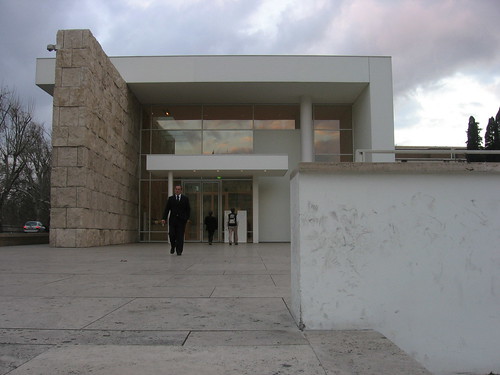
California modernism comes to Rome and ends up worse for wear . . .
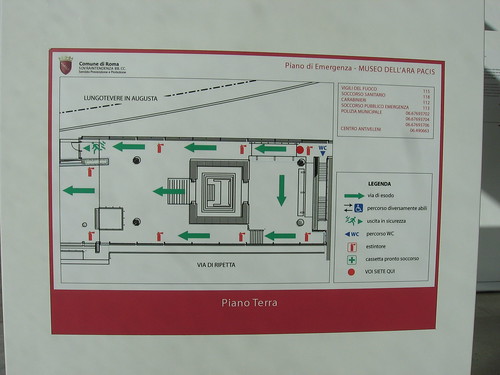
The fire-route
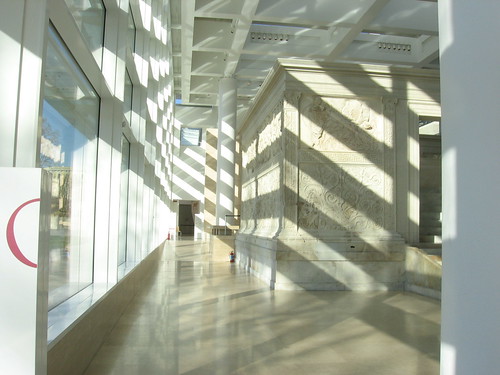
Spot the fire extinguisher
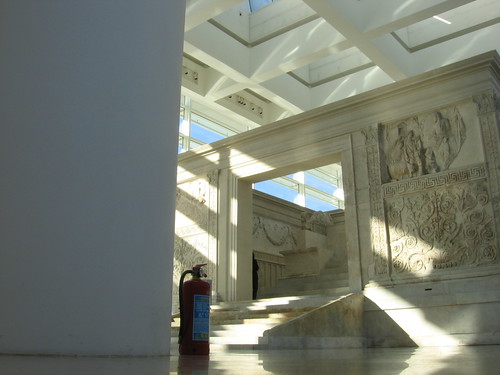
The extinguishers are laid out in a grid pattern throughout the building, layering a systemic order over the space abstracted from the context. They are red, like Tschumi's La Villette pavilions.

California modernism comes to Rome and ends up worse for wear . . .

The fire-route

Spot the fire extinguisher

The extinguishers are laid out in a grid pattern throughout the building, layering a systemic order over the space abstracted from the context. They are red, like Tschumi's La Villette pavilions.
Subscribe to:
Posts (Atom)
